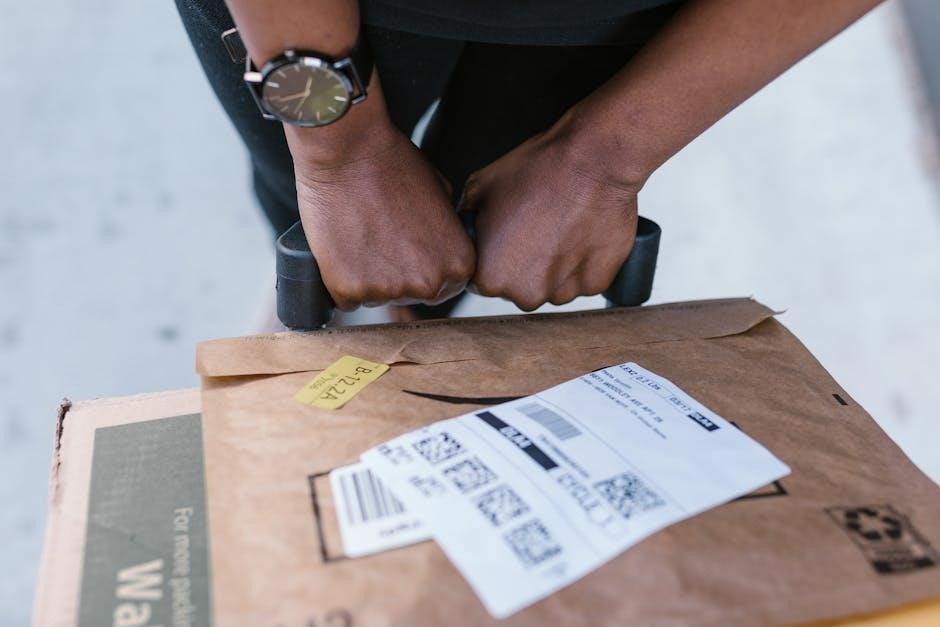Pontoon boat loading guides significantly simplify the process, ensuring proper alignment and reducing potential damage. With practice, loading becomes faster and safer. These guides are designed to aid boaters, especially in challenging conditions.
Importance of Safe Pontoon Boat Loading
Safe pontoon boat loading is crucial for preventing damage to both the boat and the trailer, avoiding costly repairs. Improper techniques can lead to dings and bends. Proper loading ensures balanced weight distribution, preventing potential accidents on the road and maintaining the boat’s integrity. By following safety guidelines and using appropriate equipment, boaters can minimize risks and ensure safe transport. Prioritizing safety preserves the pontoon’s value and maximizes enjoyment.

Preparing for Pontoon Boat Loading
Before loading your pontoon boat, ensure a smooth process with careful preparation. Inspect your trailer and tow vehicle. Proper positioning at the boat ramp is also important. A little preparation makes loading easier.
Inspecting the Trailer and Tow Vehicle
Before each pontoon boat loading session, a thorough inspection of both the trailer and tow vehicle is crucial. Ensure your tow vehicle can handle the combined weight of the pontoon and trailer. Check the trailer’s condition, including tires, lights, and brakes. Verify that the winch is in good working order and properly lubricated. Look for any signs of wear or damage that could compromise safety during loading and transport. Addressing these points helps prevent accidents.
Positioning the Trailer at the Boat Ramp
Proper trailer positioning at the boat ramp is essential for smooth pontoon loading. Back the trailer into the water, ensuring the forward end of the bunks is just visible. Avoid submerging the trailer too deeply, as this can make loading more difficult. Keep the trailer straight and aligned with the ramp. Engage the parking brake on your tow vehicle to prevent movement. A well-positioned trailer sets the stage for a safe and efficient loading process.

Step-by-Step Pontoon Boat Loading Process
Loading a pontoon boat involves careful alignment, utilizing guides, and winching. A slow, steady approach is crucial. Adjustments for water conditions are often needed. Following these steps ensures a safe and damage-free loading experience.
Aligning the Boat with the Trailer
Proper alignment is crucial for a smooth pontoon boat loading process. Slowly approach the trailer, ensuring the boat is centered. Aim to keep the boat straight, making small adjustments as needed. Focus on the nose cone of the starboard pontoon to guide the boat effectively. Use visual cues and gentle steering to correct any misalignment. Precision during this step minimizes the risk of damage and ensures a secure fit on the trailer bunks or guides. Precise alignment is key to a successful loading experience.
Using Boat Load Guides and Bunks
Boat load guides and bunks are essential for easy pontoon boat loading. Ensure pontoons align with the trailer’s guides or bunks for proper centering. These guides help correct alignment, especially in windy or rough water. Bunks support the boat’s weight, preventing damage. Adjust trailer depth so guides are just above water. The guides make loading easier, centering the boat. Proper alignment with guides and bunks ensures a safe and secure fit on the trailer, facilitating transport and preventing potential damage to your pontoon.
Winching the Boat onto the Trailer
Once aligned, use the winch to pull the pontoon boat onto the trailer. Maintain a slow and steady pace while winching, ensuring even distribution of weight. Avoid sudden jerks or excessive force, which could damage the boat or trailer. Double-check the winch cable or strap for wear and tear before use. Ensure the boat remains centered on the bunks or guides while winching. Secure the boat tightly with the winch, but avoid over-tightening. With careful winching, the pontoon boat should sit securely on the trailer for safe transport.
Essential Tips for Pontoon Boat Loading
Successful pontoon boat loading hinges on several key techniques. Slow and steady movements, adjusting for wind, and proper alignment are crucial. Practice and patience will make the process easier and safer over time.
Maintaining a Slow and Steady Approach
When loading a pontoon boat, a deliberate pace is key. Approaching the trailer slowly allows for better control and necessary adjustments. Avoid sudden acceleration or jerky movements, as these can lead to misalignment or damage. This method ensures the boat remains centered and aligned with the trailer bunks or guides, ultimately simplifying the loading process and minimizing potential issues, especially in windy conditions.
Adjusting for Wind and Water Conditions
Wind and water conditions significantly impact pontoon boat loading. In windy conditions, use the wind to your advantage, if possible, carefully maneuvering the boat. Strong currents or waves require adjustments to your approach angle and speed; A slow, steady approach is crucial, allowing for corrections as needed. Being aware of these factors and adapting accordingly ensures safer and more efficient pontoon boat loading, minimizing potential for misalignment or damage, as improper techniques can damage the boat and trailer.
Pontoon Boat Trailer Guides and Systems
Pontoon boat trailer guides and systems are designed to simplify the loading process. These systems offer enhanced control and alignment. Several types are available, each catering to different needs and boat sizes.
Types of Pontoon Boat Loading Guides
Several types of pontoon boat loading guides exist to assist boaters in safely and efficiently loading their pontoons onto trailers. These include bunk-style guides, roller guides, and specialized systems like the Pontoon Loader with unique guide rails positioned at the waterline. Some guides are designed for high winds and impact, featuring substantial contact with the logs for straight loading, working with both large and small pontoons. Selecting the appropriate type depends on the boat size, trailer configuration, and typical water conditions.
Benefits of Using Loading Guides
Using pontoon boat loading guides offers numerous advantages, making the trailering process simpler and safer. They assist in aligning the boat correctly on the trailer, reducing the risk of damage to both the boat and trailer. Loading guides are particularly helpful in windy conditions or rough water, providing a visual aid and preventing misalignment. Some systems, with unique rail designs, allow effortless docking even in challenging environments. Ultimately, loading guides enhance the overall boating experience by minimizing stress during loading.

Safety Considerations for Pontoon Boat Loading
Safe pontoon boat loading involves avoiding damage and managing weight. Improper techniques can harm the boat and trailer, leading to costly repairs. Distributing weight evenly is crucial to prevent sinking or instability during transport.
Avoiding Damage to Boat and Trailer
Preventing damage during pontoon boat loading requires careful attention and technique. Slow and steady approach minimizes impact. Align the boat properly with the trailer bunks or guides. Misalignment and speed are significant causes of dings and bends. Using pontoon-specific loading guides can protect the pontoons from scrapes. Regularly inspect the trailer to prevent any possible issues. Proper loading techniques avoid costly repairs and maintain the pontoon boat and trailer condition.
Weight Distribution and Overloading
Maintaining proper weight distribution is crucial for pontoon boat safety. Overloading can cause instability and even sinking. Ensure even distribution of passengers and gear to prevent issues. Pontoons can become unstable in waves if overburdened. Know your boat’s load capacity to avoid exceeding limits. Distribute weight evenly to avoid torpedoing and sinking. Secure loose items to prevent shifting during transport. Exceeding weight limits can lead to dangerous conditions. Prioritize passenger safety and adhere to recommended weight guidelines.
Troubleshooting Common Loading Issues
Correcting misalignment and navigating currents can be challenging. Repositioning the trailer and boat may be necessary. Patience and adjustments are key to successful loading. Strong winds can complicate matters, requiring careful maneuvering to correct any issues.
Correcting Misalignment on the Trailer
If the pontoon boat isn’t sitting squarely on the trailer, don’t force it. Back the trailer further into the water and gently reposition the boat. Focus on aligning the nose cone of the starboard pontoon. Small adjustments to the boat’s angle can make a big difference. Ensure the bunks or rollers are properly aligned before attempting to winch the boat fully. Repeat until alignment is achieved.
Dealing with Strong Currents and Waves
Strong currents and waves make pontoon boat loading difficult. Approach the trailer slowly and deliberately, using the dock as a drift break if possible. A dock hook can help to secure the boat temporarily. Maintain a steady throttle to counteract the current. If conditions are too challenging, wait for a lull or consider loading at a different ramp. Patience is key in maintaining control.
Additional Equipment and Accessories
Essential accessories streamline pontoon boat loading. Dock hooks provide assistance, while proper winch operation is crucial. Consider pontoon loaders with unique guide rails; These tools enhance safety and efficiency during the loading process.
Using a Dock Hook for Assistance
A dock hook is a valuable tool when loading a pontoon boat, especially when dealing with wind or currents. It allows you to grab onto a dock cleat or other secure point, providing leverage to maneuver the boat into the correct position on the trailer. This minimizes the risk of misalignment and makes the loading process smoother and more controlled. This will allow you to load the boat much easier in windy conditions.
Importance of Proper Winch Operation
The winch is crucial for safely pulling the pontoon boat onto the trailer. Proper winch operation involves using the correct technique to avoid strain and potential damage. Ensure the winch cable is in good condition and properly attached to the boat’s bow eye. A smooth and controlled winching process prevents jerky movements that could misalign the boat or cause injury and is a critical element in safely loading your pontoon boat every time.
Pontoon Boat Trailering Tips
Trailering a pontoon requires securing loose items to prevent them from flying off. Perform safety checks on the trailer and boat before you embark. Remember to maintain a safe distance from other vehicles.
Securing Loose Items Before Transport
Before hitting the road with your pontoon boat, meticulously secure all loose items. This includes furniture, equipment, and personal belongings. Ensure they are properly stowed or tied down to prevent them from shifting or flying out during transit. Neglecting this step can lead to damage to your boat, trailer, or create hazards for other drivers. A thorough check ensures a safer and more worry-free journey. This simple precaution contributes significantly to responsible boat ownership.
Performing Safety Checks Before Embarking
Before embarking on your journey, conduct thorough safety checks. Verify that the pontoon boat is securely attached to the trailer, with all straps and chains properly fastened. Inspect the trailer lights, brakes, and tires for any signs of damage or wear. Confirm that the winch is functioning correctly and the safety chain is connected. Double-check that all loose items are stowed away. A comprehensive safety check minimizes risks and ensures a safe and enjoyable trip for everyone involved. Prioritize safety for peace of mind.

Pontoon Boat Trailer Maintenance
Regular maintenance is crucial for pontoon boat trailers. Ensure proper bunk and roller alignment for even weight distribution. Inspect and upkeep the trailer to prevent issues. This proactive approach extends the trailer’s life.
Regular Inspection and Upkeep
Regular inspection and upkeep are paramount to ensure your pontoon boat trailer’s longevity and safe operation. Check the trailer’s frame for rust or damage, and inspect the tires for wear and proper inflation. Ensure all lights are functioning correctly for visibility. Lubricate moving parts like the winch and bearings. Tighten any loose bolts and check the condition of the safety chains and straps. Addressing these small issues prevent costly repairs.
Ensuring Proper Bunk and Roller Alignment
Proper bunk and roller alignment is critical for easy and damage-free pontoon boat loading. Verify that the bunks or rollers are evenly spaced and aligned with the pontoons. Adjust them as needed to ensure they support the boat’s weight evenly. Misaligned bunks or rollers can cause stress and damage to the pontoons. Regularly inspect the bunk carpet or roller surfaces and replace if worn or damaged. This ensures smooth contact and prevents scratches during loading and unloading.
Pontoon Boat Loading in Different Conditions
Loading a pontoon boat varies with conditions. Wind and rough water present unique challenges. Adapting techniques is crucial for safe loading. Patience and careful maneuvering are always essential, particularly when conditions are less than ideal.
Loading in Windy Conditions
Loading a pontoon boat in windy conditions can be particularly challenging. Wind can push the boat off course, making alignment difficult. Using pontoon loading guides becomes even more crucial in these situations. A slow and steady approach is vital, allowing for constant adjustments. Consider using dock hooks for added control. Patience and careful maneuvering are key to a successful and safe loading process when the wind is a factor. Proper preparation minimizes risks and helps avoid damage to the boat and trailer.
Loading in Rough Water
Loading a pontoon boat in rough water presents unique challenges. Waves and currents make it difficult to maintain alignment with the trailer. Pontoon loading guides become essential for safe and efficient loading. It is highly recommended that you keep an even load on board. Approach the trailer slowly, making constant adjustments to compensate for water movement. Utilize the winch carefully, ensuring the boat is securely attached. Patience is paramount, prioritizing safety to avoid damage to the boat and trailer. Proper technique is crucial for mastering loading in rough water.
Mastering pontoon boat loading involves understanding the trailer, boat, and conditions. Practice loading in varied situations to build confidence. By following safety tips and using appropriate equipment, you can streamline the process.
Practice and Patience for Successful Loading
Loading a pontoon boat can be tricky initially. New boaters often find it intimidating, but practice makes perfect. Repeatedly loading your pontoon will build your confidence and make the process smoother. Remember to be patient, especially when learning. Rushing can lead to mistakes, so take your time. With enough practice and patience, loading your pontoon boat will become easy.

